The Lehigh Valley Railroad was a railroad in the Northeastern United States built predominantly to haul anthracite coal from the Coal Region in Northeastern Pennsylvania to major consumer markets in Philadelphia, New York City, and elsewhere.
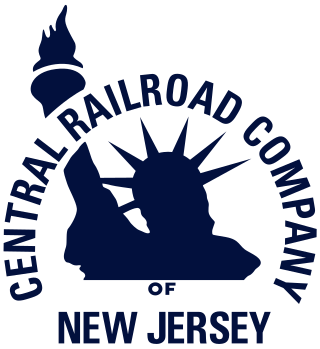
The Central Railroad of New Jersey, also known as the Jersey Central, Jersey Central Lines or New Jersey Central, was a Class I railroad with origins in the 1830s. It was absorbed into Conrail in April 1976 along with several other prominent bankrupt railroads of the Northeastern United States.

For the purposes of this article, the Jersey City area extends North to Edgewater, South to Bayonne and includes Kearny Junction and Harrison but not Newark. Many routes east of Newark are listed here.

The Raritan Valley Line is a commuter rail service operated by New Jersey Transit (NJT) which serves passengers in municipalities in Union, Somerset, Middlesex, Essex and Hunterdon counties in the Raritan Valley region in central New Jersey, United States. The line's most frequent western terminus is Raritan station in Raritan. Some weekday trains continue farther west and terminate at the High Bridge station, located in High Bridge. Most eastbound trains terminate in Newark; passengers are able to transfer to NJ Transit using a combined ticket or PATH and Amtrak to New York City. A limited number of weekday trains continue directly to New York.

The Aldene Connection is a connection between two railroad lines in the Aldene neighborhood of Roselle Park, New Jersey, United States, one formerly belonging to the Central Railroad of New Jersey (CNJ), the other formerly of the Lehigh Valley Railroad. The connections allow trains on the New Jersey Transit Raritan Valley Line to travel from Cranford and points west through stations in Roselle Park and Union to the Hunter Connection in Newark, which in turn allows access to the Northeast Corridor and Newark Penn Station.
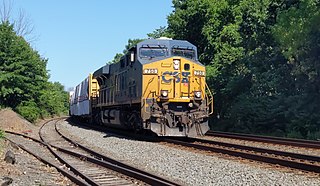
The Conrail Lehigh Line is a railroad line in New Jersey that is part of Conrail Shared Assets Operations under the North Jersey Shared Assets Area division. The line runs from CP Port Reading Junction in Manville to Oak Island Yard in Newark. The line is double-track and signaled through its entire length. The line began operations in 1999 using former existing tracks from Manville to Newark that was once part of the original Lehigh Line which is still in existence and is owned and operated by Norfolk Southern Railway.

The Central Railroad of New Jersey Terminal, also known as Communipaw Terminal and Jersey City Terminal, was the Central Railroad of New Jersey's waterfront passenger terminal in Jersey City, New Jersey. The terminal was built in 1889, replacing an earlier one that had been in use since 1864. It operated until April 30, 1967.

Easton and Amboy Railroad was a railroad built across central New Jersey by the Lehigh Valley Railroad (LVRR) in the 1870s. The line was built to connect the Lehigh Valley Railroad coal hauling operations in Pennsylvania with the Port of New York and New Jersey to serve consumer markets in New York metropolitan area. Until it was built, the terminus of the LVRR had been at Phillipsburg, New Jersey on the Delaware River opposite Easton, Pennsylvania. It is now part of Norfolk Southern Railway operations, partially the Lehigh Line

The Newark and Roselle Railway was incorporated on Aug 28, 1889 by the Lehigh Valley Railroad (LVRR) to advance tracks from the terminus of the Roselle and South Plainfield Railway at Roselle, New Jersey to Pennsylvania Avenue in Newark. It formed part of the route connecting the LVRR's Easton and Amboy Railroad at South Plainfield to the Jersey City terminal.

The Newark and Passaic Railway was incorporated on Nov 22, 1889 by the Lehigh Valley Railroad (LVRR). It was chartered as a short line in Newark, New Jersey from the Passaic River to a connection with the LVRR's Newark and Roselle Railway near Pennsylvania Avenue in Newark. The lower mile of its length closed a gap in the route of the LVRR from South Plainfield to Jersey City.
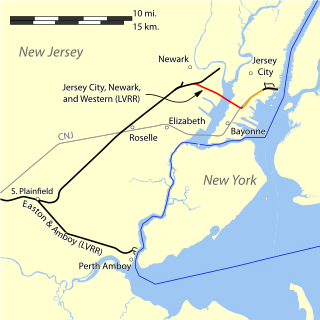
The Jersey City, Newark and Western Railway was incorporated on July 6, 1889, and acquired by the Lehigh Valley Railroad (LVRR). Construction was completed in 1893. It started in Jersey City, New Jersey at a connection with the National Docks Railway in Communipaw east of the Central Railroad of New Jersey line, and extended westward on the bridge across Newark Bay to connect with the LVRR's Newark and Passaic Railway.

The Newark Railway was incorporated on December 10, 1890, and was a short, 1-mile connection between the Lehigh Valley Railroad's Newark and Roselle Railway and the Pennsylvania Railroad (PRR). Upon completion on Feb 16, 1891, all passenger traffic, which had previously been routed to the PRR at Metuchen, instead took the route from South Plainfield to Newark, where it connected with the PRR and continued to the PRR station in Jersey City. The Newark Railway also served a LVRR freight and coal depot at Pennsylvania Avenue, adjacent to the PRR junction.
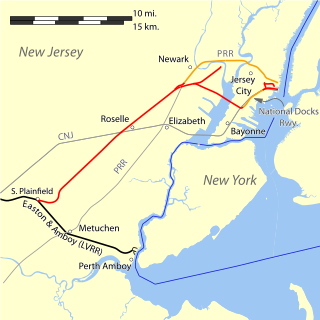
The Lehigh Valley Terminal Railway was a Lehigh Valley Railroad company organized in 1891 through the consolidation of the companies that formed the Lehigh Valley's route from South Plainfield through Newark to Jersey City via its bridge across Newark Bay. Until 1895, when the Greenville and Hudson Railway was constructed, the Lehigh Valley depended on the National Docks Railway to reach the Hudson River terminal.

The Upper Bay Bridge, or the Lehigh Valley Railroad Bridge, is a vertical lift bridge spanning the Newark Bay in northeastern New Jersey. It is used by CSX Transportation travelling through the North Jersey Shared Assets Area of the United States rail network along the National Docks Secondary line. The bridge is just north and parallel to the New Jersey Turnpike's Newark Bay Bridge. A notable train using the bridge is the Juice Train, which originates in Florida.
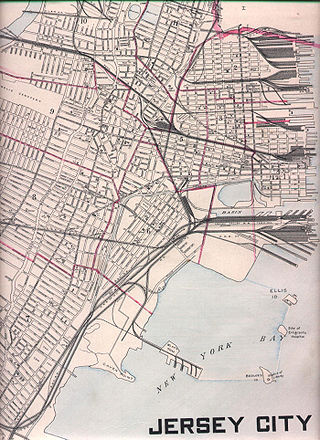
National Docks Secondary is a freight rail line within Conrail's North Jersey Shared Assets Area in Hudson County, New Jersey, used by CSX Transportation. It provides access for the national rail network to maritime, industrial, and distribution facilities at Port Jersey, the Military Ocean Terminal at Bayonne (MOTBY), and Constable Hook as well as carfloat operations at Greenville Yard. The line is an important component in the planned expansion of facilities in the Port of New York and New Jersey. The single track right of way comprises rail beds, viaducts, bridges, and tunnels originally developed at the end of the 19th century by competing railroads.

The Lehigh Line is a railroad line in Central New Jersey, Northeastern Pennsylvania, and the Lehigh Valley region of eastern Pennsylvania. It is owned and operated by the Norfolk Southern Railway. The line runs west from the vicinity of the Port of New York and New Jersey in Manville, New Jersey via Conrail's Lehigh Line to the southern end of Wyoming Valley's Coal Region in Lehigh Township, Pennsylvania.

Harbortown is a planned community neighborhood in Perth Amboy in Middlesex County, in the U.S. state of New Jersey. It is situated south of the Outerbridge Crossing along the Arthur Kill, between the city's traditional waterfront and the Kinder Morgan terminal The 135-acre area was the Lehigh Valley Railroad's (LVRR) Easton and Amboy Railroad's marshaling yards where coal was loaded onto barges until the LVRR's bankruptcy in 1976.
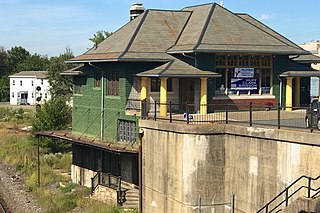
Phillipsburg Union Station is an active railroad station museum, in Phillipsburg, New Jersey, United States, at 178 South Main Street. Opened in 1914, Union Station was built by the Delaware, Lackawanna & Western Railroad (DL&W) and shared with the Central Railroad of New Jersey (CNJ) and was situated where the lines merged before the bridge crossing the Delaware River. Designed by Frank J. Nies, the architect who produced many of DL&W stations now listed state and federal registers of historic places, the 2+1⁄2 story, 3 bay brick building is unusual example of a union station and a representation of early 20th century Prairie style architecture. The Phillipsburg Union Signal Tower, or PU Tower, is nearby, also restored to its original form, and available for tours.

The Queen of the Valley was a named train of the Central Railroad of New Jersey (CNJ) that ran between Jersey City, New Jersey, and Harrisburg, Pennsylvania, via the Lehigh Valley and Reading. The train took about 4 1⁄2 hours to traverse the 179.5-mile (288.9 km) route, the longest in the CNJ system, exceeding the Atlantic City-bound Blue Comet. First operated in 1911, it was the longest-running train of the CNJ when discontinued in 1967.

 The Roselle and South Plainfield Railway was a railroad built by the Lehigh Valley Railroad (LVRR) in 1888 to connect the LVRR's Easton and Amboy Railroad with the Central Railroad of New Jersey (CNJ), and provided access over the CNJ to the Hudson River waterfront in Jersey City. The LVRR had built coal docks in Perth Amboy when it built the Easton and Amboy in the 1870s, but it desired a terminal on the Hudson River close to New York City.
The Roselle and South Plainfield Railway was a railroad built by the Lehigh Valley Railroad (LVRR) in 1888 to connect the LVRR's Easton and Amboy Railroad with the Central Railroad of New Jersey (CNJ), and provided access over the CNJ to the Hudson River waterfront in Jersey City. The LVRR had built coal docks in Perth Amboy when it built the Easton and Amboy in the 1870s, but it desired a terminal on the Hudson River close to New York City.
















